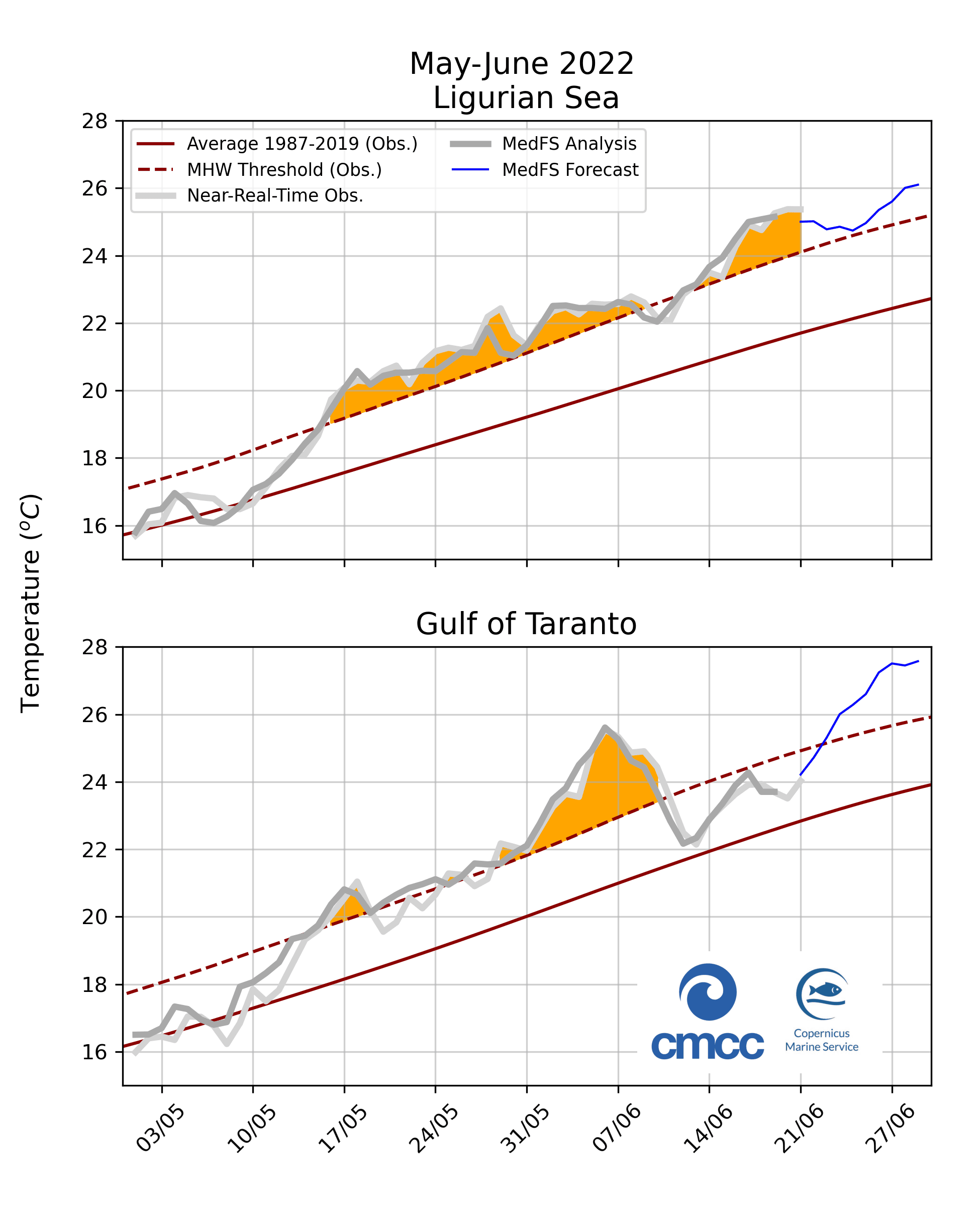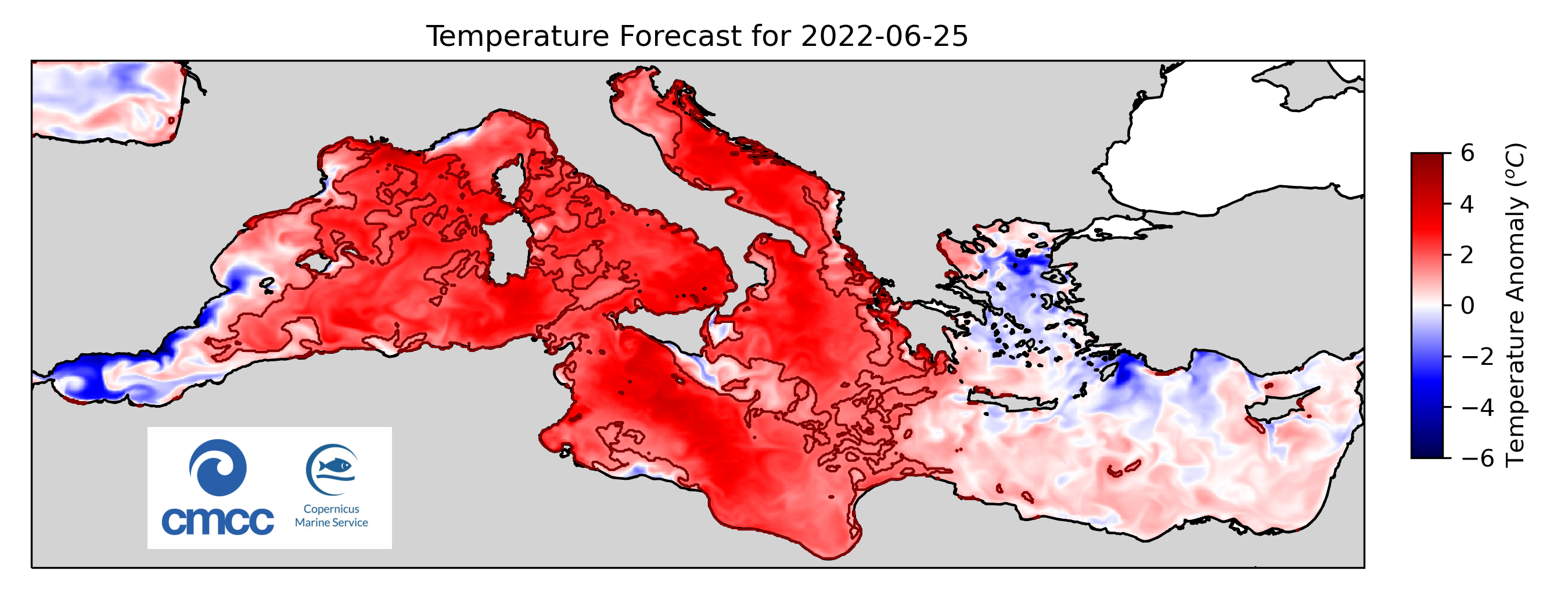
Current temperatures in the Ligurian Sea and the Gulf of Taranto are warmer than usual, with levels nearly 5oC above average. How will the situation evolve in the near future, and how similar is it to the heatwave we experienced in 2003? Here we look at the analyses produced by CMCC on marine heatwaves in the Mediterranean Sea.
Bologna, June 23, 2022 – A marine heat wave (MHW) that began at the start of May 2022 is now spreading eastward across the Mediterranean Sea.
MHWs occur when ocean temperatures cross an extreme threshold for more than 5-days in a row. In the last month, two anticyclones have brought blistering air from subtropical Africa to the Mediterranean Sea. Recent satellite Sea Surface Temperature (SST) observations, delivered through the Copernicus Marine Service, confirm the startling effect this hot air has had on the sea. For example, the Ligurian Sea experienced MHW conditions for 3-weeks before they decayed and returned in mid-June. The MHW hit the Gulf of Taranto later but with greater intensity, reaching nearly 5oC above average.
Monitoring and forecasting MHWs will become critical for assessing and avoiding damage to ecosystems and crucial economic activities such as fishing and aquaculture. CMCC maintains the Mediterranean Forecasting System (MedFS), which produces forecasts of the next 10 days as well as a reconstruction of the recent past known as analysis, both of which are freely available on the Copernicus Marine Service. In the past two months, the MedFS analysis has been successful in accurately capturing the surface temperature onset, persistence, and decay of the current extreme conditions.
Produced on Tuesday, June 21, the forecast realized for the end of June predicts that the MHW will persist weakly in the Ligurian Sea but continue intensifying in the Gulf of Taranto. The MHW will still cover most of the western basin but continue spreading across the Adriatic and Ionian Seas.
In May 2003, the conditions were similar to those we observe nowadays. They were followed in July and August by the most severe, long-lasting, and ecologically-devastating events on record. Since then, the number, duration, and intensity of MHWs have continued to increase across the Mediterranean Sea. At the CMCC, ongoing work in the FEVERSEA ESA Research Fellowship (Dr. Giulia Bonino) and the EuroSea project (Dr. Ronan McAdam) will continue to advance research in the understanding and prediction of MHWs in this vital region of economic activity and biodiversity.
* CMCC scientists Ronan Mc Adam, Giulia Bonino, Emanuela Clementi, and Simona Masina contributed to this article.
Sea surface temperatures in the Ligurian Sea and Gulf of Taranto in May and June 2022.
 Average and MHW threshold temperatures (defined as the 90th percentile of temperatures for each date) are calculated from long-term observed (“obs.”) satellite data. Near-real-time satellite data is the most up-to-date data provided by the same satellites. Orange shading is used to highlight when the observed temperature is above the MHW threshold; such conditions which last for 5 days or more are considered a MHW.
Average and MHW threshold temperatures (defined as the 90th percentile of temperatures for each date) are calculated from long-term observed (“obs.”) satellite data. Near-real-time satellite data is the most up-to-date data provided by the same satellites. Orange shading is used to highlight when the observed temperature is above the MHW threshold; such conditions which last for 5 days or more are considered a MHW.
Forecast of sea surface temperature for 25th June 2022, produced on 21st June 2022.
 The anomaly is the difference between the predicted and average temperatures (i.e., red indicates warmer than normal).
The anomaly is the difference between the predicted and average temperatures (i.e., red indicates warmer than normal).
The dark red contour highlights where the MHW threshold has been crossed for that day.


